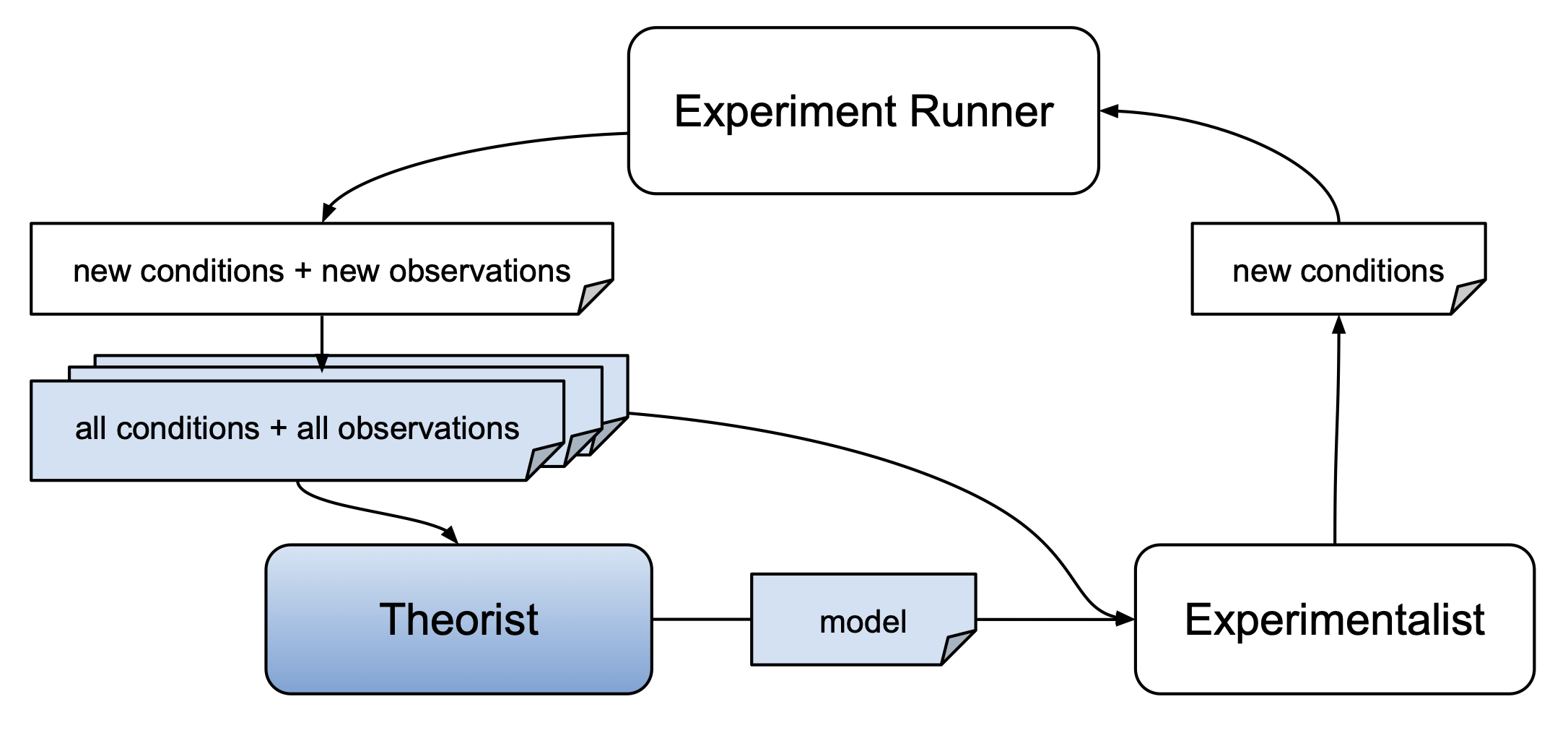Contribute A Theorist
AutoRA theorists are meant to return scientific models describing the relationship between experimental conditions and observations. Such models may take the form of a simple linear regression, non-linear equations, causal graphs, a more complex neural network, or other models which
- can be identified based on data (and prior knowledge)
- can be used to make novel predictions about observations given experimental conditions.

All theorists are implemented as sklearn regressors. They are fitted based on experimental conditions and respective
observations, and can be used to predict observations for new experimental conditions.
Repository Setup
We recommend using the cookiecutter template to set up a repository for your theorist. Alternatively, you use the unguided template. If you are using the cookiecutter template, you can set up your repository using
cookiecutter https://github.com/AutoResearch/autora-template-cookiecutter
Make sure to select the theorist option when prompted. You can skip all other prompts pertaining to other modules
(e.g., experimentalists) by pressing enter.
Implementation
Once you've created your repository, you can implement your theorist by editing the __init__.py
file in
src/autora/theorist/name_of_your_theorist/. You may also add additional files to this directory if needed.
It is important that the __init__.py file contains a class called NameOfYourTheorist which
inherits from
sklearn.base.BaseEstimator and implements the following methods:
fit(self, conditions, observations)predict(self, conditions)
See the sklearn documentation for more information on
how to implement the methods. The following example __init__.py illustrates the implementation
of a simple theorist
that fits a polynomial function to the data:
"""
Example Theorist
"""
import numpy as np
import pandas as pd
from typing import Union
from sklearn.base import BaseEstimator
class ExampleRegressor(BaseEstimator):
"""
This theorist fits a polynomial function to the data.
"""
def __init__(self, degree: int = 2):
self.degree = degree
def fit(self, conditions: Union[pd.DataFrame, np.ndarray],
observations: Union[pd.DataFrame, np.ndarray]):
# fit polynomial function: observations ~ conditions
self.coeff = np.polyfit(conditions, observations, deg = 2)
self.polynomial = np.poly1d(self.coeff)
pass
def predict(self, conditions):
return self.polynomial(conditions)
Note, however, that it is best practice to make sure the conditions are compatible with the polyfit. In this case, we will make sure to add some checks:
"""
Example Theorist
"""
import numpy as np
import pandas as pd
from typing import Union
from sklearn.base import BaseEstimator
class ExampleRegressor(BaseEstimator):
"""
This theorist fits a polynomial function to the data.
"""
def __init__(self, degree: int = 2):
self.degree = degree
def fit(self, conditions: Union[pd.DataFrame, np.ndarray],
observations: Union[pd.DataFrame, np.ndarray]):
# polyfit expects a 1D array, convert pandas data frame to 1D vector
if isinstance(conditions, pd.DataFrame):
conditions = conditions.squeeze()
# polyfit expects a 1D array, flatten nd array
if isinstance(conditions, np.ndarray) and conditions.ndim > 1:
conditions = conditions.flatten()
# fit polynomial function: observations ~ conditions
self.coeff = np.polyfit(conditions, observations, deg = 2)
self.polynomial = np.poly1d(self.coeff)
pass
def predict(self, conditions):
# polyfit expects a 1D array, convert pandas data frame to 1D vector
if isinstance(conditions, pd.DataFrame):
conditions = conditions.squeeze()
# polyfit expects a 1D array, flatten nd array
if isinstance(conditions, np.ndarray) and conditions.ndim > 1:
conditions = conditions.flatten()
return self.polynomial(conditions)
Important Considerations for sklearn BaseEstimators
When working with sklearn's BaseEstimator, it's crucial to ensure that any arguments passed to the __init__ function of a derived class are assigned as instance attributes. This is a requirement in sklearn to maintain consistency and functionality across its estimators.
For instance, the following code will raise an error because input_argument does exist as an input to the init-method but not as a class member:
from sklearn.base import BaseEstimator
class ExampleRegressor(BaseEstimator):
def __init__(self, input_argument):
print(input_argument)
theorist = ExampleRegressor('test')
print(theorist)
input_argument should be explicitly set as a class attribute, like this:
from sklearn.base import BaseEstimator
class ExampleRegressor(BaseEstimator):
def __init__(self, input_argument):
self.input_argument = 'something arbitrary'
print(input_argument)
theorist = ExampleRegressor('test')
print(theorist)
By assigning arguments as instance attributes (e.g., self.input_argument), your class will behave as expected within the sklearn framework.
Next Steps: Testing, Documentation, Publishing
For more information on how to test, document, and publish your theorist, please refer to the general guideline for module contributions .